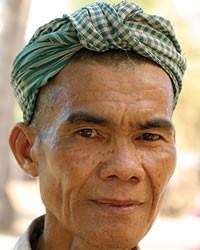Cham, Western in Cambodia

Photo Source:
Copyrighted © 2026
Cambodia Research Network All rights reserved. Used with permission |
Send Joshua Project a map of this people group.
|
| People Name: | Cham, Western |
| Country: | Cambodia |
| 10/40 Window: | Yes |
| Population: | 269,000 |
| World Population: | 342,300 |
| Primary Language: | Cham, Western |
| Primary Religion: | Islam |
| Christian Adherents: | 0.01 % |
| Evangelicals: | 0.01 % |
| Scripture: | New Testament |
| Ministry Resources: | Yes |
| Jesus Film: | Yes |
| Audio Recordings: | Yes |
| People Cluster: | Cham |
| Affinity Bloc: | Southeast Asian Peoples |
| Progress Level: |
|
Introduction / History
The Western Cham (or Khmer Islam) live near Cambodia's major cities, including Phnom Penh, and along the Mekong River. They speak Western Cham, a Malayo-Polynesian language that uses an old Devanagari script-the alphabet in which many modern Indian languages are written.
Long ago, the Cham had a strong empire, called Champa, located in southern Vietnam. Although Champa was always at war, it flourished until the late 1400s. In 1471, Champa was invaded and destroyed by the Vietnamese, and most freemen and aristocrats fled to Cambodia. Only recently has there been a revival of Cham national pride, spurred on by governmental promises of ethnic freedom. Cambodia thrived until 1969, when civil war between the government and the Communist Khmer Rouge threw the country into turmoil. Hundreds of thousands of Cambodians died while the Khmer Rouge ruled (1975-1979).
In 1975, the Khmer Rouge regime nearly destroyed Cambodia. Widespread starvation led to the deaths of over one million people. Currency was abolished, medicine was forbidden, religion was eradicated, and education was suspended. Many people were massacred, sometimes because they could read; other times simply because they wore eyeglasses. This was all done in the name of "ideal rural social reform."
In 1975, more than 250,000 Muslim Cham lived in Cambodia. With the rise of the Khmer Rouge regime, however, their population was decimated. From the beginning, the Cham were singled out as a minority group and subjected to annihilation because they practiced Islam. Captured and removed from their homes, they were forbidden to speak their native language and forced to eat pork, which is an abomination to Muslims. Thousands escaped to the forests; but they were pursued and killed. About 100,000 Cham were said to have been executed at that time, and the survivors were dispersed into small groups. The few Cham who successfully concealed their identities often died from disease or starvation.
What Are Their Lives Like?
Today, the remaining Cham survive by farming, fishing, building boats and light commerce. Bombing, civil war, and war with the Vietnamese have brought an end to the once thriving agricultural economy. The soil is not fertile, but the plains flood every rainy season. This overflow is full of fish while it lasts and leaves rich alluvial deposits when it recedes.
Cham villagers are extremely poor, and their settlements convey a sense of impermanence. Homes are made of split bamboo and are elevated above the ground to protect against flooding. Their diet of fish, rice and vegetables is adequate, but most other necessities of life are severely lacking. The typical home has few adornments and domestic utensils.
The Cham in Cambodia have preserved some of their original traits, such as the position of authority held by the maternal uncle. However, for the most part, they are entirely integrated into the Cambodian lifestyle and many now speak Khmer (Cambodian). Cham society is matrilineal (line of descent is traced through the women). This is because more men than women were killed between 1975 and 1979, creating a skewed sex ratio. Women now must perform the duties that once belonged to the men.
What Are Their Beliefs?
At the climax of the Champa Empire, two cultural influences predominated: the Hindu culture of India and the Islamic culture of the Malay. Consequently, the Cham practice a distorted version of Shia Islam. A special tradition is the burying of their dead twice. Immediately after death, the person is buried in a temporary grave. After a year has passed, his bones are removed and taken to a permanent place to be buried with his rings.
What Are Their Needs?
Although mission agencies have worked among the Western Cham of Cambodia, progress has been slow. Economic and social oppression limit the opportunities for the Cham.
Prayer Points
Pray that mission agencies will be granted God's wisdom and favor to operate freely among the Cham.
Ask the Lord to call additional long-term laborers who are willing to go to Cambodia and lovingly share Christ with the Western Cham.
Ask God to strengthen, encourage, and protect the few known Western Cham Christians.
Ask God to raise up prayer teams who will faithfully stand in the gap and intercede for these precious people.
Ask the Lord to raise up strong local churches among the Western Cham people in Cambodia.